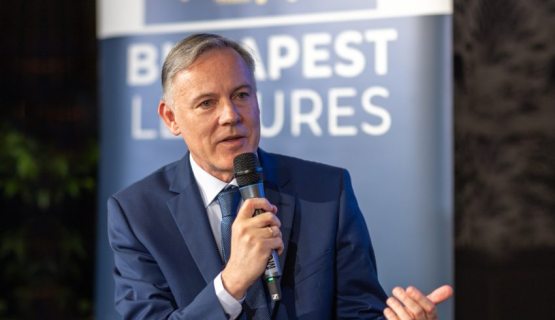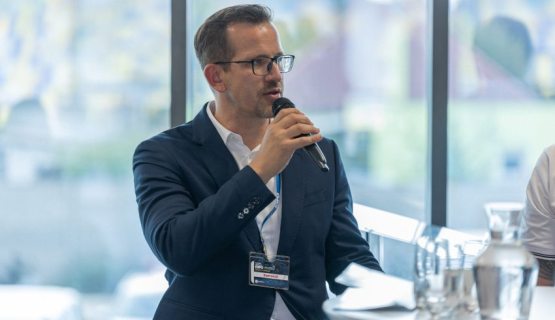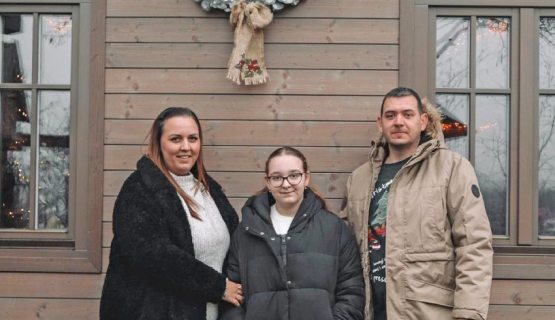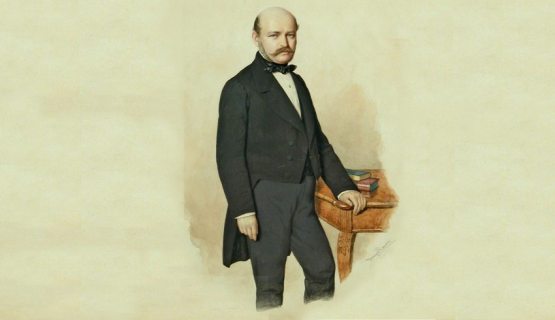The knowledge of Anna Dévény lives on in the movements of physiotherapists
If therapy starts in time, then the Dévény Special Manual Technique & Gymnastics Method (DSGM) established by Anna Dévény will help 80 out of every 100 young children. The results speak for themselves, the good reputation of the Foundation is spread by word of mouth, there is no need for marketing and even so the waiting list is long indeed.

Anna Dévény, ‘Aunt Panni’, spent nearly 40 years perfecting her method. She devoted her entire life to this and refused to give up when she found herself working in the midst of attacks on her professional standing. Right to the end she believed that the Creator had entrusted her with a special task. She was proven correct, the results of her method are indisputable, as proved by a series of professional acknowledgements today. But following the death of Aunt Panni, has it been possible to preserve the purity of her method and carry on her legacy? I spoke with DSGM specialist physiotherapist Zsuzsanna Mézám at the headquarters of the Foundation in Széll Kálmán Square.
Zsuzsanna: “It is two years almost to the day that Aunt Panni is no longer with us physically, yet while we are working we ‘sense’ her, it is as though her spirit still resides within the walls of the building. We all miss her a great deal.”
Who and in what way does the Dévény method help?
Zsuzsanna: “I would divide the children who come to us into two main groups: one includes premature babies and children who have more serious neurological or orthopaedic injuries. The second group, they are in the majority, experience minor abnormalities or disorders. The parents, district nurse and paediatrician see these but trust that they will grow out of the problem since every child develops in a different way. Unfortunately, it is our experience that these minor faults do not go away.
“If a child’s musculature is tight or loose, his or her body posture is asymmetric, there are tensions and contractions in the musculoskeletal and connective tissue system, the motor development of the child can diverge and this may cause serious problems later on in life.
“The fact is, motor development is closely associated with the development of cognitive abilities. The ‘minor faults’ may be disguised but they remain within the child and then later, at school, they really become apparent. The children concerned find it difficult to sit in one place, they are constantly fidgeting, they find it a problem to copy from the blackboard to the exercise book, many are dyslexic, dysgraphic or struggle with other learning difficulties. They may well be highly intelligent, it is just that they are unable to perform to the best of their abilities. We bear a huge responsibility to notice whether besides the movement aspect a given child also requires, for example, optical or audio development therapy.”
On entering the treatment room, we are met by Nikolett, a smiling mother, who is cradling her beautiful one-year-old daughter. I was informed before the meeting that Zsófika was born well ahead of term, which was very tough for the family. Nikolett felt it important that, by talking about her own story, she could help other parents in a similar situation.
How did you come into contact with the Dévény Anna Foundation?
Nikolett: “Zsófi was born in the 25th week and we spent three and a half months in various hospitals. She weighed 770 grams at birth and was about 30 cm. Already in Péterfy Hospital one of the doctors suggested that as soon as we left we should definitely get in touch with the Foundation, but luckily my mother had also heard and read a huge amount about the achievements of Anna Dévény. After they released us from hospital, we felt that we had been left to look after ourselves.
“It would have been a huge help, particularly given the emotional state we were in then, had somebody given us even a few telephone numbers and informed us about exactly what sort of help our premature baby girl needed.
“In November we contacted the Foundation and we received an appointment for an examination in January.”
What state was Zsófika in at that time?
Nikolett: “When we contacted the Foundation, we could already see on Zsófi that she didn’t move in the same way as her sibling at that age. It was only with great difficultly, indeed with increasing difficulty that she moved her head, she didn’t support herself on her forearms and we couldn’t even bend her limbs. We look at the corrected age of premature babies, she should have been born in the middle of October but she arrived in early July. In other words, she is one year old but one has to look on her as being an eight-and-a-half-month-old baby, she should move, pay attention and have verbal skills for this level. Wherever we took her for check-ups they always told us that given her corrected age everything was fine but in this regard we were far from being reassured.”
Zsuzsanna, what did you find on your first examination?
Zsuzsanna: “When Zsófika arrived for an examination it was love at first sight as far as I am concerned. I saw a tiny, poorly child.
“She could really only turn her head to the left, which is no surprise because she was probably put down on her tummy in the incubator since this was the only way for her to breathe.
“I really wanted to help them. I have my own children so I was able to understand the desperate situation when it is a child, a person’s most precious treasure, at stake.”
Nikolett: “Trust was immediately established and we also secretly hoped that we would get Zsuzsi. A massive weight fell from my shoulders when she called and said that she would treat Zsófi once a week.”
Zsuzsanna: “Zsófika’s corrected age was three months when we started the therapy. It is our experience that we can reach better results with treatment that starts early. The regenerative capacity of the nervous system is greater in early childhood. Then in the following months it gradually declines.”
Six months has passed since January. Where are you with Zsófi now?
Nikolett: “She was able to turn her head even after the first two therapy sessions. Zsuzsi have great advice for home as well. One was that when lying on her tummy, we should put a rolled-up towel under her armpit. We didn’t really know how we could help her, we had no idea whether her back, shoulders or arms were tense, or all at once. Thanks to Zsuzsi’s advice, we came to the next session with Zsófika being able to support herself – even though not for long – on her forearms. We really needed these rapid results for us to calm down a bit.”
What was the next milestone?
Nikolett: “Zsófi does something new two days after virtually every treatment. It was spectacular when she started reaching out for things, when she held her head steady when lying prone. A difficult movement became a joy to move. Today, she loves to kick and move about, she is smart and strong. She loves coming here, she never cries, she has a great relationship with Zsuzsi. She only tends to make a fuss if I go to the bathroom. She didn’t do this before. It sounds strange but I’m delighted by this because this level of separation anxiety and attachment is another sign of development.”
Not all babies bear treatment so well. If they cry, what is the reason?
Zsuzsanna: “We treat the children very carefully but the excessive muscle tension and contraction must be resolved. Obviously this causes some unpleasantness for the children. We always try to work with the minimum level of effort necessary for the therapy to be effective yet not causing unnecessary pain. The stimulation of the nervous system that Zsófika is undergoing is certainly painless.”
Nikolett: “We also do a lot at home with the homework Zsuzsi gives us. Thank God Zsófi is no longer lagging behind, she is more or less where she should be based on her corrected age. She’s been crawling for a week.”
How long is treatment expected to last?
Zsuzsanna: “Until she has learnt to move independently and correctly. When she starts to climb nicely, then she gets a longer break of a few weeks.
“At the major motor development milestones we like to give time for the baby to practice and perfect the given movement form.
“Motor development does not have to be rushed, the important thing is quality of movement, but we always have to be on guard: if a form of movement is delayed or appears in an irregular form, then we must help.”
How can parents, adrift in the ‘sea’ of treatments and various therapies, be sure that it is the Dévény method that will be most effective for their child?
Zsuzsanna: “The Dévény method can be used successfully in all areas of locomotor rehabilitation, but we can achieve the best results in motor development of infants. Parents share between themselves amazing stories they have heard, besides which an increasing number of neurologists, orthopaedic specialists, paediatricians and district nurses are recommending the method.
“80% of children treated by the Foundation become fully functioning children.
“Children falling into the other 20% require further development or they are children born with serious orthopaedic lesions or damage to the nervous system, and we are able to effect only minor improvements in their condition or prevent muscle wastage.”
Is the waiting list long?
Zsuzsanna: “It takes about one month to six weeks from the time parents phone up to having their children examined, but after that we can put the child into therapy immediately, assuming he/she requires it.”
How much does the treatment cost?
Zsuzsanna: “Treatment is supported by the National Health Insurance Fund of Hungary (NEAK), and the Foundation is maintained by the Ministry of Human Resources (EMMI).
“In addition, we tender, companies and private individuals support the Foundation, but we also need the donations of parents to keep the operation going. We ask for a contribution of HUF 4000 per session from those who can afford it, but this can be reduced. This is the same not only in our Budapest centre but at 13 clinics around the country as well.”
Has the method been copied? How can one avoid tricksters?
Zsuzsanna: “Unfortunately, we frequently receive negative feedback from parents about ‘therapists’ who are not listed with the Foundation, in other words, they are not trained DSGM physiotherapists. We can only accept responsibility for colleagues we know. Anybody can phone our central call line and we are happy to provide information about experts who belong to us. There is massive oversubscription for the DSGM physiotherapist training course and we are capable of training only 26 therapists every two years. Applicants have to pass a rigorous selection procedure and those physiotherapists are preferred who make the application from settlements where there are either no DSGM therapists, or only a few.”
Anna Dévény, Aunt Panni, frequently said that she hoped there would be others who would carry on the good work, and who would be capable of preserving the purity of the method. Is this guaranteed, in your view?
Zsuzsanna: “I can answer this with an unequivocal yes. Anna Dévény devoted particular attention to gathering around her those dedicated professionals humble to the method who were capable of carrying on her work. Here I would first like to mention Margit Klein Hubikné, the current professional manager of the Foundation, who was the first physiotherapist to work alongside Anna Dévény. We, her successors, bear a huge responsibility not only to preserve the purity of the method but also that we scientifically underpin the insights of Anna Dévény, which are far ahead of their time. I thank God that I had the chance to know her!”





